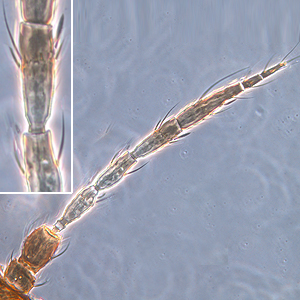Figures
Fig. 1: Antenna (inset: IV. and V. antennal segment)
Fig. 2: Head dorsal with ocellar triangle
Fig. 3: Pronotum
Fig. 4: Meso- and metanotum
Fig. 5: Fore- and hindwing
Fig. 6: Sternites VI and VII
Fig. 7: Tergites IV and V
Fig. 8: Tergites VIII and IX
ITS-RFLP gel patterns (1&8 ladder, 2 PCR-product, 3 RSAI, 4 HaeIII, 5 MspI, 6 HinfI, 7 AluI)
Fig. 9: Primer pair CS249/CS250
Fig. 10: Primer pair O1/18J
Fig. 11: Primer pair P1/28Z
Fig. 12: Primer pair 18SMP/28SMP
Taxonomic Information
Species:
Echinothrips americanus Morgan, 1913
Synonyms:
Dictyothrips floridensis Watson, 1919
Common name:
None established
Present taxonomic position:
Family: Thripidae Stephens, 1829
Subfamily: Thripinae (Stephens) Karny, 1921
Genus: Echinothrips Moulton, 1911
Species Recognition
General information about the genus Echinothrips:There are eight species within this genus and the common characters that separate them from other genera include transverse striate reticulation, ocelli set on a slightly raised mound between eyes, head about as long as wide, antennae eight segmented, simple sense cones on antennal segments III and IV, and most have strong reticulation on the head, pronotum and lateral sides of the tergites.
Typical character states of Echinothrips americanus:
Body color
Mainly brown
Antennae
Number of antennal segments: 8
Segments II and III shape: more or less symmetric
Segments III & IV sensoria: emergent and simple
Base of sensorium on antennal segment VI: no more than 2 times as wide as base of nearest seta
Terminal antennal segments: rarely elongate
Head:
Distance between bases of ocellar setae III: greater than width of first ocellus
Head shape between compound eyes: distinctly prolonged
Ocellar setae III on head: arising on anterior margin of, or in front of, ocellar triangle
Postocular setae I: present
Surface of head, pronotum and fore legs: without strong reticulate sculpture
Ocellar setae I in front of anterior ocellus: present
Prothorax
Number of pairs of elongate pronotal setae: 0-3
Number of pairs of elongate posteroangular pronotal setae: 1-2
Pronotum shape: rectangular
Number of pairs of pronotum posteromarginal minor setae: 1
Mesothorax
Mesothoracic endofurca: with median spinula
Metathorax
Metanotal median area sculptured lines: with mainly equiangular reticulation
Metanotal median setae position: arising behind anterior margin
Metanotum: with campaniform sensilla
Metanotum major sclerite: with two major sclerites, metascutum and metascutellum
Metanotum median area: with at least some equiangular reticulation
Metanotum sculpture: without dominant sculptured triangle medially
Metathoracic endofurca: transverse, sometimes with simple median spinula
Wings
Wings: present and more than half as long as abdomen
First vein of forewing: distinct from costal vein
Forewing anterior margin: with setae and cilia but cilia longer than setae
Forewing color: alternating bands of dark and light
Forewing costal fringe of cilia: arising at anterior margin of wing
Forewing costal setae at middle of wing: longer than median width of wing
Forewing first vein setal row: complete, with setae closely and uniformly spaced
Forewing posterior margin cilia: undulated near apex
Forewing second vein setal row: with no setae
Forewing surface: not reticulate
Forewings: with veins, setae and microtrichia
Legs
Fore tibial apex: not extending around fore tarsus
Mid and hind tarsi: with two segments
Abdomen:
Abdominal pleurotergites: not covered in microtrichia
Abdominal segment X: never tubular, longitudinally incomplete ventrally in both sexes
Abdominal sternite II: with marginal setae but no discal setae
Abdominal sternite III of female: without glandular areas
Abdominal sternite VII median marginal setae: arising in front of margin
Abdominal sternites IV , V and VI: with marginal setae but no discal setae
Abdominal tergites: without curved wing-retaining setae
Abdominal tergites IV & V median setal pair: longer than distance between their bases
Abdominal tergites V-VII: without paired ctenidia, sometimes with irregular microtrichia
Setae on abdominal tergite X: slender
Ctenidia on tergite VIII: not present, but groups of microtrichia
Tergite VIII posteromarginal comb of microtrichia: present, complete medially
Tergite VIII posteromarginal microtrichia: long, slender and regular
Biology
Life history:
As with other thrips species the life cycle from egg to adult is dependent on temperature and has been documented to range from 5.8 to 15.5 days for egg development, and 5.6 to 33.9 days for larvae to develop to adults.
Host plants:
Impatiens (Balsaminaceae), Euphorbia (Poinsettias), greenhouse ornamentals, Dieffenbachia, Syngonium.
Vector capacity:
None identified
Current known distribution:
Europe, Eastern North America, Thailand
Additional notes:
Leaf feeding by thrips resembles mite damage. Leaves become chlorotic or bleached and the leaf tissue becomes shrunken. Flowers become disfigured from thrips feeding. This species has been documented as a serious pest in greenhouses throughout the Eastern US. Its distribution is known from Canada to Florida and west as far as Iowa.
Bibliography
Childers, CC & Nakahara, S (2006): Thysanoptera
(thrips) within citrus orchards in Florida: Species distribution, relative
and seasonal abundance within trees, and species on vines and ground
cover plants. - Journal of Insect Science 6.
Collins, DW (1998): Recent interceptions of Echinothrips
americanus Morgan
(Thysanoptera, Thripidae) imported into England. Entomogist´s mounthly
magazine 134, 1-3.
Moritz G, Morris DC, Mound LA (2001): ThripsID - Pest thrips of the world. ACIAR and CSIRO Publishing Collingwood, Victoria, Australia, CDROM ISBN 1 86320 296 X.
Moritz G, Mound LA, Morris DC, Goldarazena A (2004): Pest thrips of the world - an identification and information system using molecular and microscopial methods. CBIT, University of Queensland,CDROM ISBN 1-86499-781-8.
Mound, LA & Marullo, R (1996): The thrips of Central
and South America: An Introduction (Insecta: Thysanoptera). Associated
Publishers, Gainesville.
Mound, LA & Kibby, G (1998): Thysanoptera: An identification
guide, Second edition.
Stannard, LJ (1968): The thrips, or Thysanoptera,
of Illinois. Illinois Natural History Survey Bulletin 29: 215-552.
Vierbergen, G, Cean, M, Szeller, HI, Jenser,
G, Masten, T & Simala, M (2006): Spread of two thrips pests
in Europe: Echinothrips americanus and Microcephalothrips
abdominalis (Thysanoptera: Thripidae). Acta Phytopathologica et
Entomologica Hungarica 41: 287–296.
Links:
Mound, LA (2005): Thysanoptera (Thrips) of the World
- A Checklist. http://www.ento.csiro.au/thysanoptera/worldthrips.html













